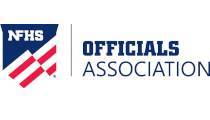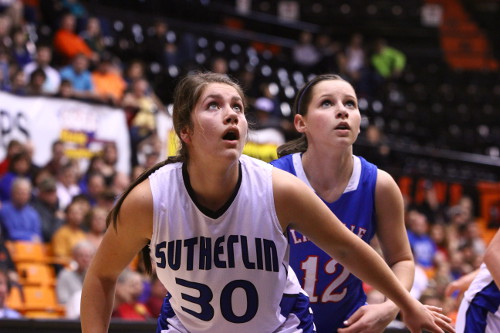
Basketball
Players in marked lane spaces will be able to move into the lane when the ball is released by the free-throw shooter beginning with the 2014-15 high school basketball season. Previously, players could not release until the ball touched the ring or backboard or until the free throw ended.
This change in Rule 9-1-4 was one of four major rules changes recommended by the National Federation of State High School Associations (NFHS) Basketball Rules Committee at its April 14-16 meeting in Indianapolis. All recommendations were subsequently approved by the NFHS Board of Directors.
The committee noted that the current rule of players in marked lane spaces not releasing until the ball touches the ring or backboard creates two obstacles for officials: 1) attempting to watch the ball strike the ring or backboard while simultaneously attempting to observe if any players/free thrower violate the lane-line restrictions, and 2) insufficient time for the perimeter official(s) to obtain optimum angles on the players involved in rebounding a missed try.
“In recent years, we have moved players along the lane spaces up and removed excess players along the lane lines, so the rationale for changing this rule to its current status is no longer an issue,” said Theresia Wynns, NFHS director of sports and officials education and staff liaison to the NFHS Basketball Rules Committee.
In an effort to eliminate excessive contact on ball-handlers and dribblers outside of the lane area, the committee added Article 12 to Rule 10-6 on contact. As a result, the following acts will constitute a foul when committed against a ball-handler/dribbler: 1) placing two hands on the player, 2) placing an extended arm bar on the player, 3) placing and keeping a hand on the player and 4) contacting the player more than once with the same hand or alternating hands.
The rules committee also expanded the definition of an intentional foul in Rule 4-19-3d, which now states that an intentional foul is “excessive contact with an opponent while the ball is live or until an airborne shooter returns to the floor.”
Wynns said that this revision will address the issue of contact with the elbow and should reduce the subjectivity in making rulings on intentional fouls.
In the final rules change, the committee expanded Rule 3-5-3 by identifying anything worn on the arm and/or leg as a sleeve, except a knee brace. These items, including tights, will now be permitted but must meet the color and logo restrictions in Rule 3-5-3. Previously, this rule permitted only arm sleeves and leg-compression sleeves.
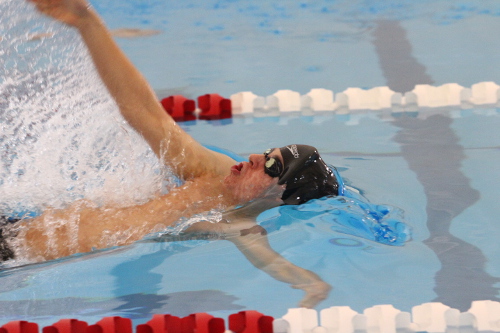
Swimming and Diving
A major change in the finish of the backstroke event will occur next year in high school swimming and diving.
Effective with the 2014-15 season, any part of a swimmer’s body must be on or above the water at the finish of the backstroke event. Previously, a swimmer in the backstroke could submerge on the turn and/or finish.
This revision in Rule 8-2-1e was one of eight rules changes recommended by the National Federation of State High School Associations (NFHS) Swimming and Diving Rules Committee during its March 30-April 1 meeting in Indianapolis. These recommendations were subsequently approved by the NFHS Board of Directors.
“There’s been a difference of opinion as to what constitutes a finish, and the committee believed it needed to be cleared up,” said Becky Oakes, NFHS director of sports and liaison to the Swimming and Diving Rules Committee. “Clarification is going to focus on the finish and that the swimmer remains on the surface of the water.”
Three changes were approved in Rule 9 pertaining to diving. First, Rule 9-2-2 now allows an option for reseeding divers going into finals in championship meets. Diving finalists may now be seeded from lowest to highest based on their individual scores through the semifinals. Previously, the diving order used at the beginning of the meet was maintained throughout the competition. The new option for diving finals is decided by the meet director prior to the beginning of the meet.
“Divers in finals can be seeded based on their score, which can change the order from the starting order of divers,” Oakes said. “The committee felt that this option would add excitement to the meet. Divers with higher scores can see their competition.”
The committee also adjusted the scale for judges to score divers by revising five of the seven categories. The new scoring, which is consistent with the NCAA, USA Diving and FINA, is as follows:
- Excellent – 10
- Very Good – 8.5 to 9.5
- Good – 7 to 8
- Satisfactory – 5 to 6.5
- Deficient – 2.5 to 4.5
- Unsatisfactory – 0.5 to 2
- Failed – 0
The final diving revision (Rule 9-2-1) seeks to minimize risk of injury by permitting practice dives during specified warm-up times prior to each diving session. Divers are allowed at least two practice approaches – with or without water entry – prior to the start of the diving competition. This allows divers an opportunity to warm up after a break in competition.
The committee made additions to Rule 3-6 relating to the penalties for unsporting conduct during a swimming and diving meet. Unsporting conduct results in disqualification from the meet, including previous events in which a competitor qualified for the finals.
New Rule 3-6-3 states that no team personnel or competitor should display unacceptable conduct, including not following the official’s directions or using profanity. The penalty is disqualification from the event.
“The committee wanted to separate unsporting conduct from unacceptable conduct. The severity of the penalty needs to match the severity of the unbecoming conduct,” Oakes said. “The new rule separates the two so that each situation is dealt with based on the severity of the action by the competitors or coaches.”
Rule 3-6-2 now deals strictly with spectator conduct and allows the referee to suspend the meet until the meet management resolves the situation. Previously, spectator penalties were included with the penalties for athletes.
Another change dealing with risk minimization was Rule 8-1-5, which states that swimmers no longer may step off the starting platform when the referee says “Stand up.” Referees and starters should direct swimmers to step down only when unusual circumstances occur.
Following are other changes approved by the rules committee:
- Rule 3-3-4: Adhesives are not allowed for swimmers or divers.
- Rule 4-3-1Note: The sounding device shall not be a pistol or closed barreled starter’s pistol.
A complete listing of all rules changes will be available on the NFHS website at www.nfhs.org. Click on “Athletic Activities” in the sidebar menu on the home page, and select “Swimming and Diving.”
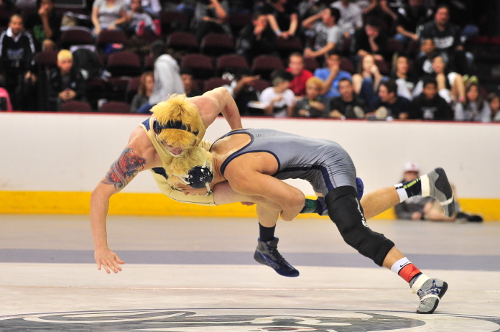

Wrestling
High school wrestling rules changes focused on changes in the definition of bad time and advancement of wrestlers in the consolation bracket.
Changes to Rules 5-1-1 and 10-2-9 were recommended by the National Federation of State High School Associations (NFHS) Wrestling Rules Committee at its April 14-16 meeting in Indianapolis. The committee’s recommendations were subsequently approved by the NFHS Board of Directors.
In addition to previous language in Rule 5-1-1, the committee agreed that bad time is wrestled with the wrestlers in the wrong position or the wrong wrestler being given choice of position “at the start of the second 30-second tiebreaker” and “at the start of the ultimate tiebreaker.”
The previous definition did not include situations where the wrong wrestler was given choice of position at the start of the second 30-second tiebreaker or the start of the ultimate tiebreaker.
Rule 10-2-9 previously addressed the protocol when two wrestlers in the championship bracket simultaneously could not continue the match but did not address a plan for advancement to the consolation bracket when points had been scored in the match.
The additional language will state that if the match is tied at the time of termination, the wrestler who scored the first point(s) in the match (first three periods, or first or second 30-second tiebreaker) will continue in the consolation bracket. If no points were scored, neither wrestler will continue.
“I am very proud of the NFHS Wrestling Rules Committee’s work,” said Alan Beste, chair of the NFHS Wrestling Rules Committee and assistant executive director of the Iowa High School Athletic Association. “Oftentimes, people think successful committee meetings are only accomplished when numerous changes are made. This year, the rules committee reviewed many aspects of the high school wrestling program and determined there was no need for a large number of rules changes. We will continue to monitor the annual NFHS wrestling rules questionnaire sent to state associations, coaches and referees to determine the need for future changes.”
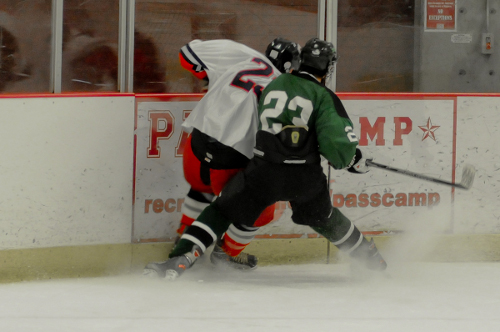
Ice Hockey
More stringent penalties for boarding and checking from behind in high school ice hockey have been approved for the 2014-15 season.
Changes to Rule 6-4 (boarding) and Rule 6-7 (checking from behind) were recommended by the National Federation of State High School Associations (NFHS) Ice Hockey Rules Committee at its April 28-29 meeting in Indianapolis. The committee’s recommendations were subsequently approved by the NFHS Board of Directors.
In its ongoing attempt to minimize the risk of injury in the sport, the committee increased the penalty for boarding (Rule 6-4-1) to an automatic major. Previously, it was only a major for a flagrant violation of the rule, which states: “No player shall check, cross-check, elbow, charge or trip an opponent in such a manner that causes the opponent to be thrown violently into the boards.”
Now, if a flagrant violation of boarding (6-4-2) occurs, or if the check causes the player to crash headfirst into the boards, either a major and misconduct penalty, or a game disqualification penalty, must be assessed.
“Increasing the first level of penalty for boarding should act as a deterrent when combined with proper teaching and education,” said Dan Schuster, NFHS staff liaison to the committee who also serves as NFHS assistant director of coach education. “Boarding is one of the most dangerous plays in the sport, and a flagrant boarding act can carry severe consequences to participants and must be accompanied with stiff penalties.”
Equally dangerous is the act of checking from behind, and the committee increased the first penalty level to an automatic major. A violation of Rule 6-7-1, which states “No player shall push, charge, cross-check or body-check an opponent from behind in open ice,” will now be a major penalty instead of a minor and misconduct.
Schuster said that by increasing the penalties for boarding and checking from behind, the committee wanted to make it clear that this type of dangerous play has no place in high school ice hockey.
“The NFHS Ice Hockey Rules Committee continues in its belief that the main threat to the health of high school ice hockey is violent and reckless play,” said Tom Shafranski, assistant director of the Wisconsin Interscholastic Athletic Association and chair of the NFHS Ice Hockey Rules Committee. “The safety and well-being of the participants is paramount and the primary focus of this committee.”
Among the points of emphasis formulated by the committee for the coming season are player safety/dangerous hits, concussion recognition and management, proper communication to eliminate unsportsmanlike conduct and taunting, and proper equipment.
NFHS
Most Recent Articles
- nfhs news NFHS Learning Center Delivers 25 Millionth Course
- Track & Field/Cross Country article Effective Communication with Athletes and Coaches
- nfhs news Player Equipment Changes Highlight 2025 High School Football Rules Revisions
- Player Equipment Changes Highlight 2025 High School Football Rules Revisions
- nfhs news Judgment Call on Second Contact Eliminated in High School Volleyball





